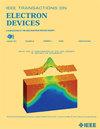用于扩展swir的InP型ii型超晶格光电二极管上InGaAs/GaAsSb的优化:从模拟到光电二极管表征的综合研究
IF 3.2
2区 工程技术
Q2 ENGINEERING, ELECTRICAL & ELECTRONIC
引用次数: 0
摘要
近年来,人们对短波红外(eSWIR)波段的兴趣日益浓厚。目前最先进的III-V短波红外探测器是与InP衬底匹配的InGaAs光电二极管(pd)晶格,受截止波长为1.7~\mu $ m的限制。与II-VI技术相比,基于超晶格的探测器具有扩展探测范围的潜力,同时提供更高的工作温度、简化的外延生长和降低的制造成本。这样的解决方案可以突破短波红外探测的界限,并在国防、天文学和其他需要增强红外成像的领域实现新的应用。在这种情况下,泰雷兹公司、III-V实验室和马赛天体物理实验室正在合作探索一种利用超晶格扩展SWIR探测范围的新方法。基于成熟的InGaAs-on-InP技术,提出了一种三层应变补偿超晶格结构,以减轻载流子局部化和限制垂直传输等限制。本文介绍了最近的结果,证明了量子效率(QE)和载流子离域的显着改进,实现了高达2.5~\mu $ m的检测性能。在PD级别进行了模拟和实验表征,以评估该解决方案的性能。该研究特别关注垂直传输、载流子定位和少数载流子寿命,研究它们对成像仪整体性能的影响,以突出所提出的eSWIR探测器架构的优点和挑战。本文章由计算机程序翻译,如有差异,请以英文原文为准。
Optimization of InGaAs/GaAsSb on InP Type-II Superlattice Photodiode for Extended-SWIR: A Comprehensive Study From Simulation to Photodiode Characterization
In recent years, interest in the extended short-wave infrared (eSWIR) band has grown significantly. The current state-of-the-art III–V short-wave infrared detectors are InGaAs photodiodes (PDs) lattice-matched to InP substrates, limited by a cutoff wavelength of $1.7~\mu $ m. Superlattice-based detectors have the potential to extend detection beyond this limit while offering higher operating temperatures, simplified epitaxial growth, and reduced manufacturing costs compared to II–VI technologies. Such solutions could push the boundaries of short-wave infrared detection and enable new applications in defense, astronomy, and other fields requiring enhanced infrared imaging. In this context, a collaborative effort involving Thales, III–V Lab, and the Marseille Astrophysics Laboratory is exploring a novel approach to extend the SWIR detection range using superlattices. Building on the well-established InGaAs-on-InP technology, a three-layer strain-compensated superlattice structure has been proposed to mitigate limitations such as carrier localization and restricted vertical transport. This article presents recent results demonstrating significant improvements in quantum efficiency (QE) and carrier delocalization, achieving detection performance up to $2.5~\mu $ m. Simulations and experimental characterizations at the PD level were performed to assess the solution’s performance. The study particularly focuses on vertical transport, carrier localization, and minority carrier lifetime, examining their influence on overall imager performance to highlight the benefits and challenges of the proposed eSWIR detector architecture.
求助全文
通过发布文献求助,成功后即可免费获取论文全文。
去求助
来源期刊

IEEE Transactions on Electron Devices
工程技术-工程:电子与电气
CiteScore
5.80
自引率
16.10%
发文量
937
审稿时长
3.8 months
期刊介绍:
IEEE Transactions on Electron Devices publishes original and significant contributions relating to the theory, modeling, design, performance and reliability of electron and ion integrated circuit devices and interconnects, involving insulators, metals, organic materials, micro-plasmas, semiconductors, quantum-effect structures, vacuum devices, and emerging materials with applications in bioelectronics, biomedical electronics, computation, communications, displays, microelectromechanics, imaging, micro-actuators, nanoelectronics, optoelectronics, photovoltaics, power ICs and micro-sensors. Tutorial and review papers on these subjects are also published and occasional special issues appear to present a collection of papers which treat particular areas in more depth and breadth.
 求助内容:
求助内容: 应助结果提醒方式:
应助结果提醒方式:


